#Fibre Optic Cable Equipment
Text
High Performance Cables

Get premium-quality RJ21, Power, Ethermet, and Fibre Optic cables with same-day dispatch at CablesUK. Explore our range of Cat5e, Cat6, and server racks for all of your networking needs.Cold resistant cables, Premier cable collection, Cable collection in uk, Computer and Network Cabling, High Performance Cables, 6 Pair Flat Cable, Power Cable UK Mains, Cat6 cable in uk, Uk mains power 3 pin, Bulk audio & video cable, Cat5e utp pvc patch leads, Cat8 patch leads, Cat6a cable uk, Data cables in uk. https://cablesukltd.com/
Cold resistant cables are not only designed to withstand cold temperatures but also to endure the harsh conditions often associated with extreme environments. Whether it's exposure to moisture, ice, or mechanical stress, these cables are built to last.
With reinforced jackets, robust connectors, and precision-engineered conductors, cold resistant cables offer unmatched durability and reliability. This ensures uninterrupted operation in the face of adversity, minimizing the risk of downtime and costly repairs.
Applications of Cold Resistant Cables
Telecommunications
In the telecommunications industry, where connectivity is paramount, cold resistant cables play a vital role in maintaining reliable communication networks in cold climates or high-altitude environments. From remote cell towers to data centers located in Arctic regions, these cables ensure uninterrupted connectivity, even in the most challenging conditions.
Industrial Automation
Cold resistant cables are also essential in industrial automation systems, where they provide critical connectivity for machinery and equipment operating in cold environments. Whether it's a refrigeration unit in a food processing plant or a robotic assembly line in an automotive factory, these cables enable seamless operation, even in freezing temperatures.
Automotive Sector
In the automotive sector, where reliability is key, cold resistant cables are used in various applications, including wiring harnesses, sensors, and heating systems. These cables ensure the dependable performance of critical vehicle components, even in the coldest of climates, ensuring driver safety and comfort.
Choosing the Right Cold Resistant Cables
Consideration of Environmental Factors
When selecting cold resistant cables for a specific application, it's essential to consider the environmental conditions they will be exposed to. Factors such as temperature range, moisture levels, and exposure to chemicals or abrasion should be carefully evaluated to ensure compatibility and optimal performance.
Compliance with Industry Standards
It's also crucial to choose cold resistant cables that comply with relevant industry standards and certifications. Cables that meet recognized standards undergo rigorous testing and certification processes, providing assurance of their quality, reliability, and safety.
Customization Options
Many manufacturers offer customization options for cold resistant cables, allowing customers to tailor the cables to their specific requirements. Whether it's custom lengths, connector types, or insulation materials, these options enable users to optimize cable performance and functionality for their unique needs.
Conclusion
Cold resistant cables are the unsung heroes of modern infrastructure, ensuring reliable connectivity and performance in the face of extreme cold. With their exceptional material composition, enhanced insulation properties, and robust construction, these cables are indispensable in industries where exposure to low temperatures is a constant challenge.
By understanding the importance of cold resistant cables and choosing the right options for specific applications, industries can ensure seamless operation, minimize downtime, and safeguard critical systems and equipment against the elements.
0 notes
Text
Comprehensive Guide to Residential Data Cabling in Sydney
In today's digital age, a robust and efficient data cabling infrastructure is fundamental to any modern Sydney home. As we increasingly rely on high-speed internet and smart home technologies, the importance of professionally installed residential data cabling cannot be overstated. This guide provides a thorough overview of residential data cabling services in Sydney, detailing benefits, types of cabling, and why choosing the right installer is crucial for your home connectivity and smart technology needs.
Why Invest in High-Quality Residential Data Cabling?
Enhanced Internet Speeds: Proper data cabling ensures that you enjoy the fastest possible internet speeds, reducing buffering times and enhancing your online experience.
Future-Proofing: With technology constantly evolving, a well-planned data cabling system allows for easy upgrades and expansions, accommodating future technological advancements.
Reliability: High-quality cabling minimizes the risk of downtime and connectivity issues, ensuring reliable access to digital services and home automation systems.
Increased Property Value: Homes equipped with advanced data cabling systems are more attractive to potential buyers, often resulting in a higher resale value.
Types of Residential Data Cabling
Cat6 and Cat6a Cables: These ethernet cables are designed for high-speed data transmission, supporting speeds up to 10 Gbps over distances up to 100 meters. They are ideal for households with heavy internet usage and smart home devices.
Fibre Optic Cabling: Offering superior speed and reliability, fibre optic cables are the best choice for ultra-high-speed internet connections, capable of handling gigabit speeds with ease.
Coaxial Cables: Typically used for cable television and internet services, coaxial cables are durable and resistant to signal interference, providing a stable connection for your entertainment needs.
Choosing the Right Data Cabling Installer in Sydney
Selecting the right professional for your residential data cabling needs in Sydney is paramount. Here are a few tips to ensure you make the best choice:
Look for Experience and Expertise: Choose a company with a proven track record of successful installations in residential settings.
Check Reviews and References: Seek feedback from previous customers to gauge the installer's reliability and quality of work.
Consider the Scope of Services: Opt for an installer who offers a comprehensive range of services, including planning, installation, and after-sales support.
Assess the Quality of Materials: Ensure the installer uses high-quality cables and components to guarantee the longevity and performance of your data cabling system.
Implementing Your Residential Data Cabling Project
A well-executed data cabling project involves several key steps:
Initial Consultation: Discuss your specific needs and expectations with the installer, including internet usage patterns, smart home devices, and future-proofing considerations.
Site Assessment: A professional installer will assess your home's layout and existing infrastructure to design an optimal cabling solution.
Installation: Skilled technicians will carry out the installation with minimal disruption to your home, ensuring all cables are neatly routed and properly connected.
Testing and Certification: After installation, comprehensive testing is conducted to verify the system's performance and reliability, with certification provided for peace of mind.
Conclusion
Investing in a high-quality residential data cabling system is essential for Sydney homeowners looking to enhance their connectivity, embrace smart home technologies, and future-proof their properties. By choosing the right type of cabling and a reputable installer, you can ensure a seamless, efficient, and reliable home network that meets all your digital needs.
0 notes
Text
Utility Locating: The Critical Role of EML in Detecting Underground Utilities
Nowadays, our cities and landscapes are crisscrossed by a hidden network of utilities. From water and gas pipelines to electrical and communication cables, these essential services lie just beneath our feet.
One of the most crucial aspects of any construction or excavation project is utility locating, particularly Electromagnetic Location (EML) Locating. This blog post will explore the significance of EML Locating, focusing on how it's used to detect conductive utilities and why it's indispensable in today's urban and suburban environments.
The Essence of Utility Locating
Utility locating is a process used to identify and label underground public utility mains. These services include lines for telecommunication, electricity distribution, natural gas, cable television, fibre optics, traffic lights, street lights, storm drains, water mains, and wastewater pipes. Accurate utility locating is critical to avoid damaging these utilities during construction activities, which can lead to service disruptions, costly repairs, and, in some cases, serious injuries or fatalities.
What is EML Locating?
Electromagnetic Location (EML) Locating is a specialised technique used in utility locating. It's particularly effective for finding conductive utilities, such as metallic pipes and cables. EML Locating works by applying an electromagnetic frequency to the ground and then detecting the signal using specialised equipment. This method allows for accurately detecting and mapping underground utilities without excavation.
The Importance of EML Locating in Utility Detection
Safety: The primary importance of EML locating is safety. Accurately locating underground utilities helps prevent accidents that can occur during digging or excavation.
Cost-Efficiency: EML Locating helps avoid the costs associated with accidentally cutting into a utility line, which can be exorbitant regarding repair costs and potential fines.
Time-Saving: By knowing exactly where utilities are located, project planners can design around them, saving time that would otherwise be spent on rerouting or repairs.
Preservation of Infrastructure: This technology ensures that the existing underground infrastructure is preserved, reducing the need for unnecessary disruptions and repairs.
Applications of EML Locating
Construction Projects: Before any construction project begins, it's crucial to know the location of underground utilities to prevent any potential hazards.
Maintenance and Repair: For routine maintenance or repair work, EML Locating helps quickly identify the precise location of the utility that needs attention.
Urban Planning: In city planning and development, EML Locating maps out existing utilities, aiding in efficiently planning new projects.
Home Renovations: EML Locating can be critical for small-scale projects like home renovations, especially when extensions or modifications are being made.
Choosing the Right EML Locating Service
Selecting an experienced and reliable EML Locating service is crucial. Look for providers with a track record of accuracy and reliability, and ensure they use the latest technology and methods. It's also vital that they understand the local regulations and compliance standards.

Conclusion
Utility locating, particularly EML Locating, is vital in safely executing construction projects and maintaining our urban infrastructure. It's a sophisticated solution to a complex problem – finding what lies beneath the surface without disturbing it. As we continue to build and expand our cities, the importance of accurately locating and preserving underground utilities cannot be overstated. EML Locating is more than just a technical service; it's a guardian of our underground world, ensuring that our essential services remain uninterrupted and safe.
0 notes
Text
Top reasons to opt for fibre broadband
The right broadband service can make all the difference in your online experience. There are lot of brand advertising the perfect solution to broadband speed issues. If you're still on the fence switch to fibre. Here are the top five compelling reasons to make the switch.
1. No more broadband bandwidth limitations: Buffereing frustration and laggy connections will not haunt you anymore. Fiber is renowned for its lightning-fast speeds. With data traveling at the speed of light through fiber optic cables, you can enjoy quicker downloads and smoother streaming.
2. Unparalleled Reliability: It is the right choice for a stable internet connection. Unlike traditional copper cables, fiber optics are not susceptible to interference from electromagnetic signals. This ensures a reliable connection even during peak usage hours.
3. Symmetrical Upload and Download Speeds: Your upload and download speeds are nearly identical. This is a game changer for activities like video conferencing, cloud computing and uploading large files. You'll experience a balanced and efficient internet connection with fibre.
4. Broadband Troubleshooting with Future Proof Technology: Fibre optic infrastructure is considered cutting edge and is well equipped to handle the demands of emerging technologies. Fibre internet service can keep up with the advancements in the digital world for years to come.
Bottom line
Fibre is an investment in a superior online experience. From unmatched speed to unwavering reliability, fibre is a clear winner in the world of broadband connectivity. Get a quote from Cellnet to make the switch. Stop struggling with broadband speed issues and get their affordable fibre plans for uninterrupted service.
For More details on Fibre Broadband in Ireland Please visit our website: cellnet.ie
0 notes
Text
EDFA WDM PON
JP08XXEAP (2RU) series is a low noise, high performance, FTTP high power, multi-ports optical amplifier with gain spectrum band within 1540~1565nm. Each output port for optical amplifier has built-in well-performed CWDM. Every external up-link optical port of optical amplifier can connect with OLT PON port very conveniently. Each 1550nm (CATV)'s output optical port multiplex 1310/1490n's data stream, in order to reduce the quantity of the component and improve the index and reliability of the system.
JP08XXEAP edfa booster amplifier can be compatible with any FTTx PON Technology. It offers a flexible and low-cost solution for three-network integration and Fiber to the Home.
JP08XXEAP LCD at the front panel offers the work index of all equipment and warning alarms. The laser will switch off automatically if optical power is missing, which offers security protection for the laser. All the optical port of optical amplifier can be installed in the front panel or back panel.
JP08XXEAP with carrier-class reliability and network security management, high quality, high reliability and excellent cost performance and is ideal for system integrators and system operator.
How Do Fibre Optic Amplifiers and Combiners Work Together?
Fiber optic amplifiers and combiners are two essential components in optical communication systems that can work together to enhance signal transmission and network performance. Here's how they work together:
1. Amplification of Weak Signals:
Fiber optic amplifiers, such as erbium-doped fiber amplifiers (EDFAs), are used to boost optical signals that have weakened as they travel through long-distance fiber optic cables. Amplifiers are strategically placed along the optical network to increase signal strength without converting the optical signal into an electrical one, which can introduce noise and signal degradation.
2. Combining Multiple Signals:
Fiber optic combiners (also known as couplers or multiplexers) are used to combine multiple optical signals into a single fiber. This is especially useful in wavelength-division multiplexing (WDM) systems, where different data streams at different wavelengths are combined onto a single fiber for transmission over long distances.
3. Wavelength Multiplexing:
Combining multiple signals onto a single fiber using WDM technology allows for the simultaneous transmission of multiple data streams at different wavelengths. These signals can travel over the same fiber without interfering with each other. Fiber optic amplifiers placed along the route can amplify all the signals collectively, ensuring their quality and reach.
4. Enhanced Long-Distance Transmission:
By combining multiple signals and amplifying them using fiber optic amplifiers, networks can achieve long-distance transmission with minimal signal loss and improved overall performance. This combination is particularly valuable in telecommunication networks, data centers, and backbone infrastructures where high-capacity, long-haul transmission is required.
Benefits of Using the EDFA WDM PON
1. Increased Bandwidth Capacity:
EDFA WDM PON systems enable the transmission of multiple optical signals at different wavelengths (colors) over a single optical fiber. This allows for a significant increase in bandwidth capacity. Each wavelength can carry a separate data stream, effectively multiplying the network's capacity without the need for additional fibers.
2. Extended Reach:
EDFA amplifiers boost the optical signal power without converting it to electrical signals, thus minimizing signal degradation. This extended reach is particularly valuable in long-haul and rural network deployments where optical signals need to travel over extensive distances without substantial loss in signal quality.
3. Simplified Network Architecture:
WDM PON systems simplify network architecture by consolidating multiple services and wavelengths onto a single fiber. This reduces the complexity of the network, lowers operational costs, and streamlines network management. It also allows for flexible allocation of bandwidth to meet varying customer demands.
4. Enhanced Scalability and Flexibility:
EDFA-based WDM PONs offer scalability to accommodate the growing demand for bandwidth and services. As network requirements change, additional wavelengths can be added to the system without the need for extensive infrastructure upgrades. This flexibility ensures that the network can adapt to evolving customer needs and market demands.
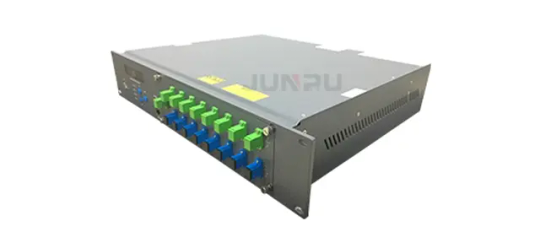
0 notes
Text
What is a Fiber Termination Unit (FTU) and How Does it Work
In the fast-paced world of telecommunications, the demand for high-speed internet and seamless connectivity has never been higher. As businesses and individuals strive for efficient and reliable communication, the backbone of these networks often lies in advanced technologies such as Fiber Termination Units (FTUs). In this blog post, we will explore the intricacies of FTUs, shedding light on their functionality, significance, and how they contribute to a robust networking infrastructure.
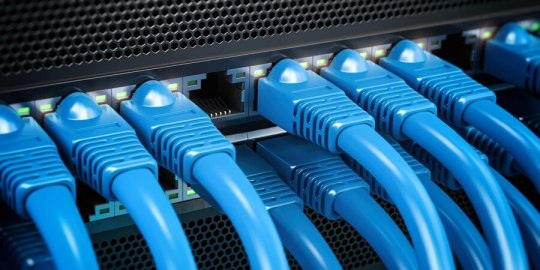
Fiber termination units, commonly known as FTUs, play a pivotal role in the last-mile connectivity of fiber optic networks. These units interface the optical fiber infrastructure and the end users, ensuring a smooth transition from the high-capacity backbone to individual homes, offices, or businesses.
Key Components of FTUs:
Optical Splitter: FTUs often incorporate optical splitters to divide the incoming optical signal into multiple outputs, allowing the network to serve multiple subscribers simultaneously.
Connectors and Adapters: FTUs are equipped with connectors and adapters to connect the optical fiber cables and the user's equipment, such as routers or switches.
Power Supply: To ensure uninterrupted service, FTUs are integrated with power supply units that support the proper functioning of the unit.
How FTUs Work:
Signal Reception: The FTU receives the optical signal from the main fiber optic network, typically a high-capacity backbone responsible for long-distance data transmission.
Signal Processing: The optical signal is processed within the FTU, and in some cases, optical splitters are employed to split the signal into multiple channels, each directed towards individual end-users.
Connection to User Equipment: The processed signal is then connected to the user's equipment, such as a modem or router, through connectors and adapters. This allows for converting the optical signal into electrical signals that standard networking devices can utilize.
Last-Mile Connectivity: FTUs enable last-mile connectivity by seamlessly transitioning the high-speed optical signal to the end-user's premises, ensuring that homes and businesses receive the benefits of high-speed fibre optic internet.
Significance of Fiber Termination Units
High-Speed Connectivity:FTUs contribute to delivering high-speed internet to end-users, meeting the growing demand for faster and more reliable communication services.
Scalability: FTUs are designed to be scalable, accommodating increasing subscribers without compromising performance. This scalability is crucial in today's dynamic and expanding network environments.
Reliability: By serving as a reliable interface between the main optical fiber network and individual users, FTUs ensure consistent and uninterrupted connectivity, minimizing downtime and disruptions.
Future-Proof Infrastructure: As technology evolves, FTUs can be upgraded or replaced to support the latest advancements in fiber optic communication. This makes them a crucial component of a future-proof networking infrastructure.
Cost-Effectiveness: FTUs contribute to cost-effective network solutions by optimizing the use of optical fiber resources and minimizing the need for extensive infrastructure investments.
Innovation in Fiber Termination Units
The field of fiber optics is continually evolving, and FTUs are no exception. Innovations in FTU technology include:
Smart FTUs: Integrating smart features into FTUs allows for remote monitoring, management, and troubleshooting, enhancing the overall efficiency of fiber optic networks.
Increased Port Density: Advancements in FTU design have led to units with higher port density, enabling network operators to serve a larger number of users with a single unit.
Energy-Efficient Solutions: Energy efficiency is a key focus in modern FTU designs, aligning with the global push for sustainable and environmentally conscious technology solutions.
Conclusion
In the ever-evolving telecommunications landscape, Fiber Termination Units (FTUs) are crucial in the journey towards efficient, high-performance networking. As the demand for high-speed internet continues to surge, FTUs play a pivotal role in ensuring that end-users seamlessly receive the benefits of fiber optic connectivity.
At Netrack India, we understand the importance of cutting-edge solutions in networking infrastructure. Our commitment to providing top-notch products, including Fiber Termination Units, reflects our dedication to supporting the digital transformation of businesses and individuals alike. With a focus on innovation, reliability, and scalability, Netrack India remains at the forefront of delivering quality solutions that empower future connectivity needs. Whether you are a telecommunications provider, a business, or an individual seeking the best networking solutions, Netrack India is your trusted partner in the journey towards a connected and digitally empowered world. Embrace the power of Fiber Termination Units and experience a new era of connectivity with Netrack India by your side.
0 notes
Text
What are the Common Data Cabling Problems and It's Solutions?
In an increasingly digital world, data cabling is the backbone of information exchange. However, data cable issues can impact productivity and lead to costly downtime. Let's take a look at some common data cabling problems and their solutions with the help of data installers in Sydney.
Cable Overload
Problem: Cables can become tangled, poorly organised and damaged over time.
Solution: Label and organise your cables regularly, use a cable management system and consider wireless alternatives when possible.

Cable Length Limitations
Problem: Ethernet cables have distance limitations that can be difficult in large spaces.
Solution: Extend the range using network switches and routers. You can also use fibre optic cables to bridge long distances if necessary.
Signal Interference
Problem: Electromagnetic interference from other devices can interfere with data transmission. Solution: According to the data installers in Sydney, covered cables help reduce interference. Keep data cables away from power cables and other potential sources of interference.
Aged Cable
Problem: As cables age, they are more prone to damage and data loss.
Solution: Regularly inspect and replace old or damaged cables for optimal performance.
Insufficient bandwidth
Problem: As data requirements increase, older cables may be unable to support high-speed requirements.
Solution: Upgrade to newer cabling standards, such as Cat 6 or Cat 6a, to ensure sufficient bandwidth for current and future needs.
Illegal termination
Problem: Connection issues can occur if the cable is not correctly terminated.
Solution: Have a trained professional or the data installers in Sydney use the proper tools and techniques to ensure cables are correctly connected.
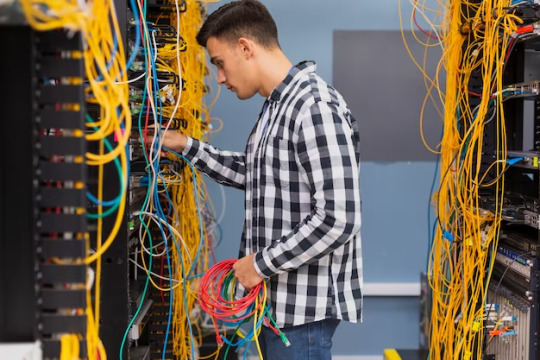
Cable Compatibility
Problem: Mismatched cables can cause connection issues.
Solution: Use a cable that matches the specifications of your network equipment. Avoid combining different types of cables.
Inappropriate Testing
Problem: Insufficient testing may result in undetected cabling issues.
Solution: Regularly test and certify cabling installations to identify and correct problems before they become critical.
Addressing these common data cabling issues ensures a reliable and efficient data infrastructure. Regular maintenance, thoughtful design and compliance with cabling standards are key to preventing and resolving cabling issues that can impact business connectivity and productivity!
0 notes
Text
Data Cabling St Marys | Data Cabling Blue mountains, NSW | One Step Ahead Communications
Data cables are used to transmit information between devices. There are three main types of data cables used to transmit data: twisted pair, coax and optic fibre cables.
These three types of cables are used in different environments. One of the fastest twisted pair cables on the market today is CAT6 cable. Data cable can be for internal or external use. Data cable for external use has a hard jacket and a moisture barrier.
Your data cable connects the following equipment to other devices and the network: computer, monitor, modem, printer, fax machine, smart TV, CCTV, wireless router, switch, phones, phone system, VOIP phones, intercom, door station, EFTPOS machine, alarm, and much more.
OSA Communications can supply, install and terminate all types of cable, such as: Optic fibre, data, coax, aerial IBC, speaker, communication (5pr, 10pr, 30pr, 50pr, 100pr), depending on what is required.
#phone system#data cables#phone systems#telephone lead-in cable installation#phone and data cabling#telephone technician#telephone repair#nbn cable repairs#phone line repairs#telephone line repairs
0 notes
Text
Fiber cleaners, insertion, and removal
Tools for fibre insertion, removal, and polishing are absolutely essential for optical fibre networks' installation and maintenance. These instruments aid by guaranteeing the longevity and proper management of broadband links.
Fiber Cleaners:
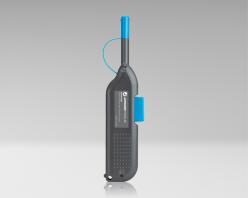
Insertion Tools:
Optical connectors are inserted using insertion tools into adapters, patch panels, and other receptacles. A safe and dependable connection is ensured by proper insertion.
Jonard Tools is committed to providing premium quality tools and products including fiber optic cleaners, insertion, and removal tools. As the low voltage industry changes and new technology is introduced, it is Jonard Tools’ mission to provide tools that meet the latest needs of all fiber optic and cabling technicians.
Jonard Tools is committed to providing premium quality tools and products including fiber optic cleaners, insertion, and removal tools.
Removal Tools:
Optical connectors can be separated from cables or receptacles easily and safely implementing removal tools without hampering the equipment or the connectors.

0 notes
Video
youtube
Best Modem for Att Fiber Review
Best Modem for AT&T Fiber
AT&T Fiber internet is an ultra-high speed service that utilizes 100% fiber optic cable technology to transmit information, providing faster downloads and greater reliability. Furthermore, fiber connections are symmetrical - meaning upload speeds will match download speeds for an ideal experience when working or playing online.
AT&T fiber service providers provide you with router and gateway. While renting is convenient, buying can often be more cost-effective (and faster). Before purchasing equipment for AT&T fiber service, be sure to choose compatible equipment - in this article we'll explore some of the top modems and routers that support AT&T fibre connections.
The TP-Link X20 wireless router for AT&T fiber boasts an impressive set of features, such as OFDMA and MU-MIMO technologies, seamless roaming with smart seamless roaming technology, beam-foaming technology, powerful antivirus protection, as well as Gigabit Ethernet ports to transfer large files or stream 4K content with strong connection stability; its three high-performance antennas can cover an area between 1,200-1,400 square feet for strong connections; it offers an easy web interface and includes value added features such as network management, parental controls and QoS.
AT&T fiber customers looking for another great Wi-Fi option should consider the Eero 6 Plus mesh Wi-Fi system, compatible with AT&T fiber. It features three high-performance antennas capable of covering an area between 1,200-1,400 square feet while supporting up to 11 devices simultaneously. Furthermore, this device features an easy web interface as well as built-in Quality of Service capabilities which let you prioritize certain apps or devices on your network.
AT&T stands out among providers in terms of customer satisfaction, and boasts one of the fastest fiber networks nationwide. Recently, AT&T Home Internet achieved an ACSI score of 80/100; one point higher than industry average and second only to T-Mobile Home Internet in this metric. The American Customer Satisfaction Index (ACSI) scores are calculated based on customer surveys about their experiences with ISPs; the higher the score is the better they rated their service and pricing plans are competitive; AT&T makes an excellent choice for families searching for fast and reliable internet. Price comparison shows that AT&T prices are considerably more cost-effective than its peers and offers a good selection of add-ons that can enhance your service experience. Furthermore, this company provides low-cost phone plans and TV packages, as well as being one of the few major carriers who offers fiber-to-the-home (FTTH). AT&T Internet service is offered across multiple states and provides various plans tailored specifically towards both business and home users. AT&T's gigabit fiber network enables businesses to boost productivity while decreasing operating costs; on top of fast Internet, AT&T also offers VoIP telephone and cellular phone services.
0 notes
Text
Benefits of Fibre Optic Cable: Why You Should Switch to This High-Speed Technology
Cable fibre changed data transport and networking. The internet and advanced networking have changed information sharing. This technology uses fibre optic cables to transport data at incredible rates across large distances. Cable fiber technology is incredible, and it is still evolving, promising even greater breakthroughs.
The ability to transfer data as light pulses rather than electrical signals defines cable fibre technology. This differs greatly from copper wires, which transmit data through electrical currents. Light-based data transfer provides quicker speeds and more capacity, expanding digital communication.

Understanding What is fibre optic cable?
Fibre-optic cable underpins cable fiber technology. This wire can transmit a lot of data across great distances. Its unique design and structure give it great power. Fiber optic cables are made of glass strands scarcely thicker than a hair. These optical cables transmit data as light pulses.
Fiber-optic cables can convey massive amounts of data using light pulses. Because of its high frequency, light can carry more information than electrical signals. Fiber optic cables are also resistant to electromagnetic interference, which disrupts copper cable data transfer.
Types of Optic Cable
There are many kinds of optic cables for different uses and situations. The major cable types are single-mode and multi-mode. Single-mode cables carry light straight down a glass fiber strand with a tiny core. For long-distance data transmission, these cables can transmit signals for tens or hundreds of kilometers without signal degradation.

The Role of Cable Fiber Optics in Computer Networking
Cables and fiber optics are essential to computer networking. Fibre optic cables are great for networking due to their high speed and capacity for data transfer. They enable fast data exchange between PCs, servers, and other network devices.
Network backbones employ fiber optic cables to link segments and ensure data flow. These are also used to link fast network equipment like switches and routers. Fiber-optic connections improve computer network speed and dependability.
Fiber Optic Cable, In Other Words
Fiber optic cables are intended to safeguard fragile glass fibers and optimize data transfer. The core, cladding, and jacket of a fiber optic cable transport light.

Why Fiber-optic cable is crucial to the Internet.
Fibre-optic cable is crucial for internet access. It connects the globe and allows high-speed data transfer as the internet’s backbone. Undersea fibre-optic cables link continents and carry most internet traffic.
Internet backbone fibre optic cables are also essential for last-mile connection. High-speed internet is being brought to homes and businesses, which will allow video streaming and cloud computing.
What are the good and bad things about fiber optic cable?
Fiber optic cable transmits data quickly using light. A core of glass or plastic is surrounded by a cladding with lower refractive index. Light pumped into the core travels down the wire as a beam.
Fiber optic cable offers a number of benefits over traditional copper cables, including:
Fiber optic lines may carry data quicker than copper wires. Because light moves quicker than electricity.
Increased bandwidth: Fiber optic cables transport more data than copper wires. This is because fibre-optic cables can carry numerous data channels but copper cables can only carry one.
Fiber optic lines can carry data over extended distances without diminishing signal strength, unlike copper wires.
Fiber optic cable has less interference from electromagnetic waves than copper wires. It is suited for use near power lines when electrical noise is high.
Fiber optic cables are more secure than copper lines due to their difficulty in being tapped without detection.

Fiber Optic Cable Price Analysis
The kind, quantity, and other variables affect the cost of fiber optic cable. In recent years, fiber optic cables have become cheaper than copper lines, making them more accessible for broad usage.

What’s next for cable-fibre technology?
The future of cable fiber technology is bright. High-capacity and reliable data transmission are needed more than ever due to the increased demand for high-speed internet and digital connections. As a scalable and future-proof digital communication option, fiber optic cables can satisfy this requirement.
Further improvements in fiber optic technology are increasing its power and efficiency. Researchers are building fibre optic cables that can carry more data and send it further. Cable fibre technology has a bright future with these advances.
Conclusion
Fibre optics technology has transformed communication. From computer networking to internet access, it’s vital to our digital lives. Power and potential make cable fiber technology important to our digital future, despite its obstacles. Cable and fiber communication will improve as technology advances.
https://inovi.co.za/benefits-of-fibre-optic-cable-why-you-should-switch-to-this-high-speed-technology/
0 notes
Text
Buy Fibre Optic Online in Australia | Mr Wifi
Get high-quality fibre optic cables and equipment online in Australia at Mr. WiFi. Browse our wide range of products and choose the best options for your network requirements.
Buy Fibre Optic Online in Australia
0 notes
Text
Comprehensive ICT and Communications Solutions for Businesses and Institutions

Communications solutions for large corporate networks to workgroup solutions. Aotea Communications are able to offer a complete ICT cabling solution including design, installation, testing, certification, maintenance and repair across a variety of different solutions that include Data centres, all office and commercial applications, education facilities, large warehouse and distribution centres and wireless deployment.
Structured Cabling
We design and build flexible cabling infrastructures, structured cabling systems that support multiple voice, data, video and multimedia systems regardless of their manufacturer. We are the "one-stop-shop" for all your network infrastructure needs. We will help you evaluate, design and install the optimum integrated system for your company. Our technicians are certified and experienced in a wide range of voice and data cabling including copper, fibre optic and wireless.
Leading brands we support include:
Commscope Systimax
Commscope NetConnect (formally AMP & Krone)
Siemon
Legrand
Hubbell
Schneider Actassi
Molex
AFL
Leviton
Panduit
Fibre Optics
Aotea Communications have one of the largest and most knowledgeable fiber optic teams in Auckland. From consulting and design through to installation including civil works, on going maintenance, termination and fault diagnostics. Aotea Communications has invested heavily in installation and test equipment and are committed to continuing to upskill our staff. Aotea can also design, supply and install GPON Networks.
WiFi
Aotea Communications can supply installation, servicing and diagnostics of all leading WiFi brands. All of our team have EWP (Elevated Work Platform) certification to support complex installations and we can back this up with in-depth WiFi cabling expertise and AP mounting experience.
MATV Systems
Aotea Communications can design, install and maintain MATV systems for hotels, motels, hospitals, nursing homes and apartments.
We have a vast amount of experience in various locations around Auckland and pride ourselves on providing a competitively priced solution that gets installed professionally and on time.
Audio Visual
With over 15 years’ experience in the commercial audio visual sector, we are experts in bringing complex AV systems together into a fully integrated and easy to use solution.
Aotea Communications provide a range of commercial audio visual solutions including AV system design, project managed installations as well as advice on aftercare and maintenance. We will help you from the design/planning stages of your project and continue to help you once the audio visual system has been installed.
Originally Found On-
Source: Aotea Electric Auckland(https://aoteaelectricauckland.co.nz/what-we-do/communications/)

1 note
·
View note
Text
How Siemens Siprotec 5 6MD86 Bay Controller Protection Relay Can Help Increase Your Grids Productivity
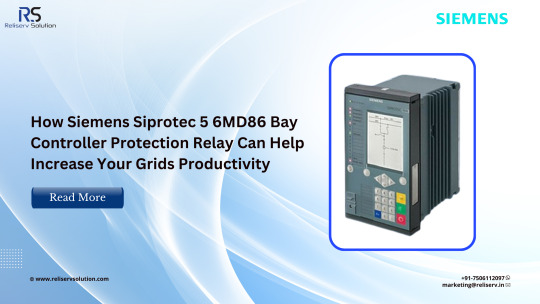
In the dynamic landscape of power distribution, ensuring the smooth and efficient operation of electrical grids is of utmost importance. To achieve this, grid operators are constantly seeking innovative solutions that can boost productivity while maintaining a high level of protection for critical assets. This article explores how the Siemens Siprotec 5 6MD86 Bay Controller Protection Relay can play a pivotal role in enhancing grid productivity. By seamlessly integrating advanced protection and control functionalities, this cutting-edge relay offers unparalleled reliability and performance, empowering grid operators to optimize their network's efficiency and ultimately contribute to a more sustainable and reliable power supply.
A Brief Overview Of Siemens Siprotec 5 6MD86 Bay Controller Protection Relay
The Siemens Siprotec 5 6MD86 Bay Controller is a protection relay device designed to provide comprehensive protection and control functionalities for electrical systems at various voltage levels, ranging from distribution to transmission. The Siemens Siprotec 6MD86 Bay Controller serves as a control and automation device with optional protection features, suitable for various voltage levels from distribution to transmission. As part of the SIPROTEC 5 family, it offers a wide range of protection functions from the SIPROTEC library, sharing identical parameters with protection devices. Its adaptable hardware design allows precise alignment with different process data requirements.
The 6MD86 Bay Controller is equipped with flexible hardware, allowing it to adapt precisely to different process data requirements, making it a versatile and effective solution for ensuring the stability and security of critical power systems. Its advanced automation capabilities enable seamless integration into control systems, enhancing the overall efficiency and reliability of electrical networks.
Functions of Siemens 6MD86 Bay Controller Protection Relay
Integrated bay controller with versatile protection function from medium to extra-high voltage
Control of switching devices
Synchrocheck, switchgear interlocking protection and switch related protection functions, such as circuit-breaker failure protection and automatic reclosing
Integrated electrical Ethernet RJ45 for DIGSI 5 and IEC 61850 (reporting and GOOSE)
Up to 4 pluggable communication modules usable for different and redundant protocols (IEC 61850, IEC 60870-5-103, IEC 60870-5-104, DNP3 serial and TCP, Modbus TCP, PROFINET IO)
Secure serial protection data communication, also over great distances and all available physical media (fibre-optic cable, 2-wire connections and Communication Networks)
Capturing operational measured variables and protection function measured values to evaluate the plant state, support commissioning, and analyze faults
Phasor Measurement Unit (PMU) synchrophasor measured values and IEEE C37.118 protocol integrated
Powerful fault recording (buffer for a max. record time of 80 s at 8 kHz or 320 s at 2 kHz)
Auxiliary functions for simple tests and commissioning
Flexibly adjustable I/O quantity structure within the scope of the SIPROTEC 5 modular system

How The Relay Works To Monitor And Protect Grid Assets
Siemens Siprotec 5 6MD86 Bay Controller Protection Relay is a sophisticated device designed to monitor and protect various assets within an electrical grid. Its primary function is to detect abnormal conditions or faults that may occur in the grid and take prompt actions to mitigate potential risks, ensuring the safety and stability of the entire power distribution system. Here's how the relay works to monitor and protect grid assets:
Fault Detection: The relay continuously monitors the grid for any abnormal conditions, such as overcurrent, undercurrent, overvoltage, Undervoltage, frequency deviations, etc. When it detects a fault or an irregularity beyond the predefined threshold, it triggers an alarm to notify operators of the issue.
Data Acquisition: The relay collects real-time data from various sensors and instruments installed throughout the grid. This data includes voltage levels, current flow, power factor, and other essential parameters. The relay processes this data to analyze the grid's operating condition.
Event Logging: The relay maintains a detailed log of events and disturbances that occur within the grid. This log provides valuable information for post-event analysis and helps engineers to understand the root cause of disruptions and take preventive measures.
Fast Tripping Mechanism: In the event of a fault, the relay's primary objective is to isolate the affected section of the grid quickly. It sends a tripping signal to the circuit breaker associated with the faulty segment, allowing it to open within milliseconds. This rapid tripping prevents the fault from spreading and causing cascading failures in the system.
Communication Capabilities: The Siprotec 5 6MD86 is equipped with communication interfaces that enable seamless integration into Supervisory Control and Data Acquisition (SCADA) systems and other grid management platforms. This allows for remote monitoring, control, and diagnostics, enhancing the overall grid management efficiency.
Real-time Condition Monitoring: The relay continuously monitors the health and performance of critical grid assets, such as transformers and circuit breakers. It provides real-time diagnostics and alerts operators of any abnormalities or degradation in equipment performance, enabling predictive maintenance and extending asset lifespan.
In summary, the Siemens Siprotec 5 6MD86 Bay Controller Protection Relay works as an intelligent guardian of the electrical grid, vigilantly monitoring its health, detecting faults, and responding rapidly to protect valuable assets. Its ability to identify and isolate faults swiftly, coupled with advanced communication and diagnostic features, helps power utilities maintain grid stability, enhance productivity, and ensure a reliable power supply to consumers.
Conclusion
In conclusion, the Siemens Siprotec 5 6MD86 Bay Controller Protection Relay stands as a game-changer for power utilities, playing a vital role in enhancing grid productivity and ensuring a reliable and secure power distribution system. By adopting these cutting-edge protection relay technologies, power utilities can pave the way for a smarter, more efficient, and sustainable energy future.
Discover the ultimate offer on the Siemens Siprotec 5 6MD86 Bay Controller Protection Relay from Reliserv Solution, your authorized Supplier and Channel Partner for SIEMENS Numerical Relays, Automation Products, Power Quality Meters & Instruments, MV Switchgear Spares, and PSS SINCAL Software. As the leading Siemens Siprotec 5 Relays supplier and exporter in Mumbai, Maharashtra, we pride ourselves on providing top-notch products and services to various industries and panel builders.
Feel free to get in touch with us at +917506112097 or email your requirements to [email protected]. At Reliserv Solution, we deal with a wide range of products, including the Siemens 6MD86 Bay Controller Protection Relay, ensuring that you have access to cutting-edge technology and reliable solutions. Don't miss out on this fantastic opportunity and contact us today for the best deals! Please click here.
#siemens#Siprotec5#protection#numerical#relays#electricalsafety#powerprotection#industrialautomation#panelbuilders#powerquality#electricalsolutions#energyefficiency#smartgrid#powerdistribution#electricalengineering
0 notes
Text
Decoding the Invisible with Utility Locating Services
Whether planning a construction project or attempting to diagnose an infrastructure issue, one essential step is often overlooked – utility locating.
Before digging or drilling, knowing what lies beneath the surface is crucial. This is where utility locating services come in. From identifying underground utilities to detecting water and gas leaks, utility locating services are vital in various industries.
What are Utility Locating Services?
Utility locating services provide an in-depth analysis of what's buried beneath the surface. These professionals use specialised equipment to locate and identify underground utilities such as pipes, cables, tanks, and even blockages or voids. This information is crucial for construction planning, excavation safety, maintenance, and infrastructure development.
Identifying What Lies Beneath
Below, we delve into the primary components that utility locating services can help identify:
Underground Utilities: Knowing the location of underground utilities is critical before undertaking any excavation or construction project. Unseen utilities can include power lines, sewer pipes, or fibre-optic cables. Accidentally striking these can lead to costly damage or even dangerous situations.
Pipes: Pipes for water, sewage, and gas crisscross beneath our feet. Utility locating services can pinpoint their precise locations, helping to prevent accidental damage and service disruptions.
Voids: These empty spaces in the ground can lead to sinkholes or ground collapse if not detected. Utility locating can identify these voids, ensuring the safety of construction workers and the integrity of any structure built on the site.
Underground Tanks: Whether they hold fuel, water, or chemicals, it's essential to know the location of any underground storage tanks. Utility locating can identify these tanks, preventing potential leaks or hazardous material exposure.
Cables: From communication lines to electricity cables, these utilities form the backbone of our modern infrastructure. Utility locating services can detect their locations and depths, which is vital for preventing service interruptions or dangerous situations during excavations.
Blockages: Detecting blockages in pipes or sewer lines is another service utility locators provide. This can help resolve issues such as water backups or slow drainage.
Water & Gas Leaks: Utility locating services can detect water or gas line leaks. This is crucial for preventing waste, property damage, or even hazardous conditions.
The Value of Utility Locating Services
The benefits of utility locating services are numerous. They ensure safety and efficiency for construction projects, preventing costly delays and possible damage to underground utilities. Homeowners can diagnose problems like leaks or blockages. For municipalities, utility locating services can help with infrastructure planning and maintenance.
These services play a vital role in managing our invisible yet critical underground infrastructure. They ensure that the essential systems we rely on daily – electricity, telecommunications, water, and gas – continue to function seamlessly.

Conclusion
Utility locating services are essential, unveiling the hidden world beneath our feet. These services help prevent costly damages, ensure safety, and contribute to efficient construction and infrastructure development planning. So, before you start your next project or need to diagnose an infrastructure problem, remember the importance of utility locating services. They help bring what's unseen to the light, guiding our decision-making and ensuring our daily lives remain undisrupted.
0 notes
Text
FIBER OPTICAL SOLUTION
Fiber Optical Communication Solution is a comprehensive and advanced system designed for efficient and reliable data transmission over long distances. It consists of various components such as fiber optic cables, transceivers, optical amplifiers, and multiplexers. This solution offers high-speed data transfer, wide bandwidth, and low latency, making it ideal for telecommunications, internet service providers, and corporate networks.
ODN Network
Optical Distribution Network (ODN for short). ODN is an FTTH optical cable network based on PON equipment. Its role is to provide optical transmission channels between OLT and ONU. In terms of function, ODN can be divided into four parts: the feeder optical cable subsystem, the distribution optical cable subsystem, the home line optical cable subsystem and the optical fiber terminal subsystem from the central office end to the user end.
Fiber Optic Solution for Triple Play Network
Triple Play Network
In short, the "Triple Play Network" are the integration between cable television, telecommunications and computer communication. The purpose is to build a sound and efficient communication network to meet the needs of social development. The three-network integration has high requirements for the application practice of technology. In the future, mobile phones can watch TV and surf the Internet. TV can call, Internet access, and computer can also call and watch TV.
Fiber Optic Solution for Telecommunication
Telecommunication
Telecommunication refers to the use of electronic technology to pass information between different places. Telecom includes different types of long-distance communication methods, such as: radio, telegraph, TV, telephone, data communication, and computer network communication. Telecom is an important pillar of an information society.
Fiber Optic Solution for Data Center
Data Center
Internet data center (IDC) refers to a comprehensive device (including high-speed Internet access bandwidth, high-performance LAN, safe and reliable computer room environment, etc.), professional management, and perfect application service platform. Based on this platform, IDC service providers provide customers with Internet basic platform services (server hosting, virtual hosting, mail cache, virtual mail, etc.), and various value-added services (rental services, domain name system services, load balancing systems, database systems, data backup services, etc.).
Fiber Optic Solution for FTTH
FTTH
Fibre (Fiber) to the Home (FTTH) is a transmission method for optical fiber communication. Specifically, FTTH refers to installing the optical network unit (ONU) at home users or business users. It is the optical access application type of the optical access to the user except FTTD (optical fiber to the desktop). The significant technical characteristics of FTTH are not only providing greater bandwidth, but also enhance the transparency of the network for data format, rate, wavelength, and protocols, relax the requirements of environmental conditions and power supply, and simplify maintenance and installation. PON technology has become a hot spot for global broadband operators, and is considered one of the best technical solutions to realize FTTH.
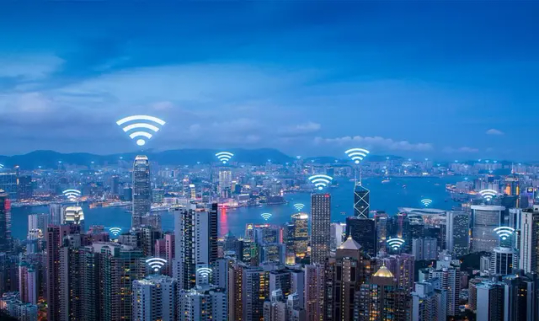
0 notes